يلعب نظام قاعدة البيانات السليمة دورًا محوريًا في دعم العمليات اليومية لأي مؤسسة. فهو يساعدك على تنظيم جميع أنواع البيانات واسترجاعها ومقارنتها، بدءًا من تتبع المخزون إلى تسجيل معلومات العملاء والمعاملات.
ومع ذلك، يتطلب إنشاء وإدارة مستودعات عالية الأداء وجود مخطط. تساعدك مخططات علاقات الكيانات في قاعدة البيانات على تطوير هذا المخطط الأولي من خلال تحديد السمات الفردية والعلاقات البينية داخل السجلات.
في الأصل اقترحه الدكتور بيتر تشين وهو عالم كمبيوتر تايواني-أمريكي من أصل تايواني، يعزز نموذج المخطط الانسيابي هذا الفهم الدقيق لمخططات قواعد البيانات للمستخدمين التقنيين وغير التقنيين.
إذا كنت تبحث عن أدوات عالية الجودة لإنشاء ERD المثالي، فأنت محظوظ! سنستكشف 10 أدوات عملية لـ ERD توفر وضوحًا مرئيًا لإنشاء نماذج قواعد بيانات متماسكة. 💯
ما هو مخطط ER Diagram؟
مخطط علاقة الكيان (ERD) هو نوع من المخططات الانسيابية المستخدمة في تصميم قاعدة البيانات. وهو يوضح البنية والعلاقات داخل قاعدة البيانات من خلال ثلاثة مكونات:
- الكيانات: تشير إلى الكائنات أو المفاهيم في قاعدة البيانات
- السمات: تحدد خصائص الكيانات. في نموذج ERD نموذجي، ستواجه أربعة أنواع من السمات:
- السمات الرئيسية هي لتحديد الهوية الفريدة
- السمات المركبة تنقسم إلى سمات أصغر
- السمات متعددة القيم_ تحتفظ بقيم متعددة
- السمات المشتقة يتم حسابها من سمات أخرى
- العلاقات: تنشئ روابط أو ارتباطات بين الكيانات، والتي يمكن أن تكون:
- واحد إلى واحد (1:1)
- من واحد إلى متعدد (1:1:N)
- واحد إلى واحد (1:1:1)
- من متعدد إلى متعدد (N:N)
يكشف هذا التفاعل بين السمات والعلاقات عن طريقة واضحة وموجزة لتصوير تنظيم البيانات داخل أي نظام معقد. لنفترض أنك تنشئ مخططات علاقات الكيانات لمدرسة - سيساعدك مخطط ER على رسم خريطة منطقية للعلاقة بين الطلاب والمقررات الدراسية وأعضاء هيئة التدريس. 🧑🏫
ما الذي يجب البحث عنه في أداة ERD
بينما يجب أن تلبي أداة ERD احتياجاتك وتفضيلاتك الخاصة، إليك بعض العوامل العامة التي يجب مراعاتها:
- المكتبات المدمجة: ابحث عن قوالب ERD ومكتبات الرموز داخل الأداة لجعلإنشاء مخطط أكثر كفاءة
- سهولة الاستخدام: من المثالي أن يكون لديك واجهة سهلة الاستخدام لا تتطلب تدريبًا مكثفًا للمستخدمين
- إمكانيات الرسم التخطيطي: ابحث عن ميزات الرسم التخطيطي الشاملة وخيارات التخصيص. الأدوات المرغوبة لديهاألواح بيانية رقمية والخرائط الذهنية لمساعدتك على صياغة مخططات تخطيط موارد المؤسسات بشكل مرئي مقنع
- توافق قاعدة البيانات: قد ترغب في أن يدعم البرنامج أو يتكامل مع نظام إدارة قواعد البيانات (DBMS) الذي اخترته
- ميزات التعاون: إذا كنت تعمل في فريق، فستحتاج إلى ميزات للتعاون في الوقت الفعلي، مثل التدقيق والتحكم في الإصدار من أجلسير العمل الفعال
- استيراد وتصدير خيارات: قد تكون القدرة على استيراد مخططات قاعدة البيانات الحالية وتصدير مخططات ER البيانية إلى تنسيقات مختلفة (على سبيل المثال، PDF، PNG، SVG) ضرورية
## أفضل 10 أدوات ERD لإنشاء مخططات قواعد البيانات في عام 2024
مع تغطية أساسيات أدوات ERD، دعنا نتعمق في أفضل 10 خيارات لاحتياجات مخطط قاعدة البيانات الخاصة بك. 😍
1. انقر فوق 
تقدم ClickUp Whiteboards جميع الميزات الإبداعية والتعاونية التي تحتاجها لإنشاء المخططات الانسيابية والرسوم البيانية عبر الإنترنت
ClickUp هي أكثر بكثير من مجرد أداة رسم تخطيطي - إنها أداة شاملة منصة إنتاجية التي تدمج المهام والمناقشات والمستندات بسلاسة.
خذ التعاونية تخطيط المفاهيم وجلسات الرسم التخطيطي إلى مستوى جديد تمامًا باستخدام كليك أب السبورات البيضاء . وهي عبارة عن لوحة قماشية حرة للعصف الذهني وتخطيط المشاريع، مما يسمح لعدة مستخدمين بالمساهمة في وقت واحد من خلال الرسومات والنصوص والصور والأشكال والموصلات والملاحظات اللاصقة وعناصر الوسائط الأخرى.
لا ترغب في بناء نموذج تخطيط موارد المؤسسة من الصفر؟ استفد من مكتبة ClickUp الواسعة من نماذج ClickUp لرسم المخططات ورسم الخرائط! قم برسم مخطط ERD الخاص بك دون عناء باستخدام قالب مخطط علاقات الكيانات ClickUp -مثالي لتخطيط هياكل البيانات المعقدة بدون مهارات الترميز.
يتيح لك قالب Whiteboard هذا إنشاء المفاتيح الأساسية والأجنبية دون عناء باستخدام الحقول المخصصة، مما يوفر نظرة سريعة على علاقات ERD الخاصة بك. إنشاء اتصالات في غضون ثوانٍ باستخدام عقد السحب والإفلات. استفد من مستويات التكبير/التصغير لنمذجة بياناتك على أي نطاق. نوصي باستخدام أتمتة ClickUp لتطبيق القيود على نماذج ER. بهذه الطريقة، يمكنك ضمان مخرجات متسقة وخالية من الأخطاء. 🥰

نمذجة مجموعات البيانات بدقة باستخدام قالب مخطط علاقات الكيانات ClickUp الخرائط الذهنية ClickUp هي ميزة تخطيطية أخرى يمكنك استكشافها. فهي تتيح لك تنظيم المشاريع والأفكار والمهام من خلال توضيح العلاقات والتسلسلات الهرمية.
بشكل عام، ClickUp هو برنامج مرئي للغاية إدارة المشروع الحل مع وجود لوحات تحكم قابلة للتخصيص ، وأكثر من 1000 خيار تكامل، وأكثر من 15 طريقة عرض يمكنك تمثيل عناصر بنية قاعدة البيانات ومراجعتها وربطها منطقيًا في لمح البصر!
ClickUp أفضل الميزات
- العصف الذهني في الوقت الحقيقي وتخطيط المشروع باستخدام اللوحات البيضاء والخرائط الذهنية
- قوالب مع شريط أدوات تخطيط انسيابي ذكي وأشكال ERD
- أكثر من 15 طريقة عرض مثل طرق عرض اللوحة والجدول للإشراف على علاقات الكيانات وتخطيطها
- سهولة تصدير واستيراد البيانات والمخططات
- واجهة السحب والإفلات لرسم الخرائط بدون تعليمات برمجية
- مستويات وصول إلى البيانات قابلة للتخصيص باستخدامانقر فوق التسلسل الهرمي لتركيز قاعدة معارف ERD الخاصة بك
قيود ClickUp
- يستغرق بعض الوقت لتعلم الميزات العديدة المتاحة
- يحتوي تطبيق الهاتف المحمول على ميزات أقل من إصدار الويب
تسعير #### ClickUp
- مجاني للأبد
- غير محدود: 7 دولارات شهريًا لكل مستخدم
- شركة: 12 دولارًا شهريًا لكل مستخدم
- المؤسسات: اتصل بالشركة لمعرفة الأسعار
- ClickUp AI متاح على جميع الباقات المدفوعة مقابل 5 دولارات لكل عضو في مساحة العمل شهريًا
* تشير جميع الأسعار المدرجة إلى نموذج الفوترة السنوي
تقييمات ومراجعات ClickUp
- G2: 4.7/5 (أكثر من 8,000 تقييم)
- Capterra: 4.7/5 (أكثر من 3000 تقييم)
2. لوسيدتشارت
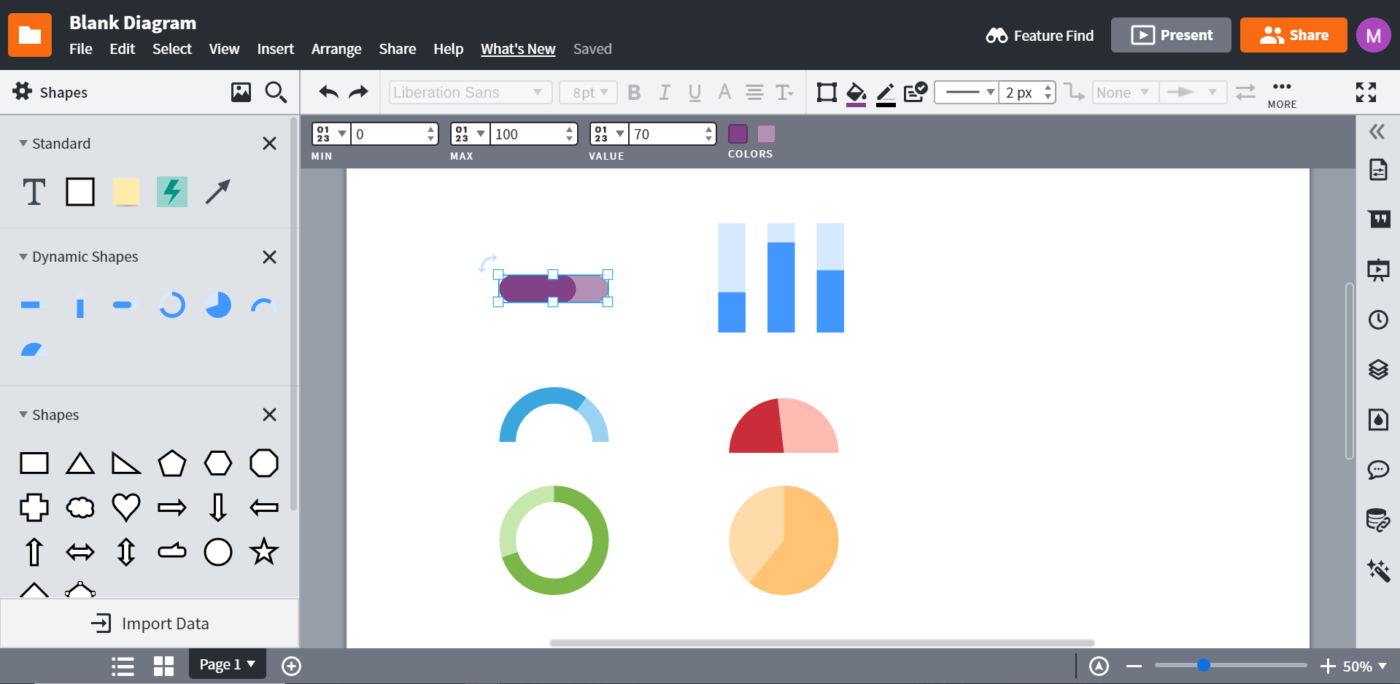
عبر: لوسيدتشارت لوسيدتشارت, مثل كبار منافسيها هو أداة متعددة الاستخدامات لصياغة مخططات تخطيط موارد المؤسسات على مستوى احترافي وأفكار تصميمية، حتى بالنسبة لمجموعات البيانات الأكثر تعقيدًا. وهي تتيح التحرير في الوقت الفعلي في السحابة، مما يجعلها خيارًا مثاليًا للفرق البعيدة والموزعة.
يمكّنك من إنشاء المخططات من الصفر أو استخدام مجموعة كبيرة من القوالب والرموز والرموز والرموز لتسريع العملية.
قم بإنشاء رسم تخطيطي فارغ والوصول إلى مكتبة أشكال لوسِدتشارت مكتبة أشكال لوسِدتشارت بالنقر على زر + أشكال من القائمة على الجانب الأيسر من الشاشة. بمجرد التمكين، يمكنك سحب وإسقاط أشكال ERD بسهولة على اللوحة، مما يمنحك بداية جيدة.
إن الربط بين هذه الأشكال بديهي بنفس القدر، حيث يمكنك الربط بينها عن طريق السحب من النقاط الحمراء على حدود الأشكال وتخصيص نهايات الخطوط باستخدام شريط الأدوات أعلى اللوحة. 🎨
أفضل ميزات Lucidchart
- التعاون في الوقت الحقيقي مع الفرق العالمية
- العديد من القوالب والرموز وخيارات التخصيص
- واجهة نظيفة وسهلة الاستخدام
- يدعم استيراد وتصدير Visio
قيود Lucidchart
- وقت تحميل دون المستوى
- يمكن أن يكون تخصيص العناصر المرئية معقدًا
تسعير #### تسعير Lucidchart
- مجاني للأبد
- فرد: يبدأ من 7.95 دولار شهريًا
- الفريق: يبدأ من 9 دولارات لكل مستخدم شهريًا
- المؤسسة: اتصل لمعرفة الأسعار
تقييمات ومراجعات لوسيدتشارت #### تقييمات ومراجعات لوسيدتشارت
- G2: 4.5/5 (أكثر من 4,000 تقييم)
- Capterra: 4.5/5 (1,000+ تقييم)
3. QuickDBDD

عبر QuickDBDD QuickDBDD هي أداة مجانية لمخطط تخطيط موارد المؤسسات (ER) إذا كنت من محبي الدقة وكفاءة لوحة المفاتيح. فهي تتيح لك رسم مخططات قاعدة البيانات بسرعة بمجرد الكتابة - كل ما عليك فعله هو تغذية المعلومات حول الكيانات، وستظهر مربعات البيانات ذات الصلة على الشاشة! ⌨️
لكن الأمر لا يتوقف عند هذا الحد!
يتألق QuickDBDD أيضًا في قسم التعاون. فميزة مشاركة الروابط الأنيقة تجعل العمل مع فريقك على الهياكل الجارية أمرًا سهلاً للغاية. بالإضافة إلى ذلك، فهو يدعم استيراد المخططات من قواعد البيانات مثل MySQL وMariaDB وOracle وSQL Server، مما يساعدك على إنشاء ERDs دون التنقل بين المنصات.
QuickDBD أفضل الميزات
- تغذية الأوامر من خلال مدخلات لوحة المفاتيح البسيطة
- مشاركة ERD خاصة أو عامة
- واردات المخطط من MySQL وMaryDB وOracle وSQL Server
- يدعم التصدير بتنسيقات PDF/RTF
قيود QuickDDBD
- يقتصر مستخدمو الخطة المجانية على 10 جداول لكل مخطط
- التخزين الخاص متاح فقط للمستخدمين المحترفين
تسعير QuickDBDD
- أساسي: مجاني
- محترف: 14 دولارًا شهريًا أو 95.00 دولارًا سنويًا
تقييمات ومراجعات QuickDBD
- G2: 4.8/5 (أقل من 5 تقييمات)
- Capterra: 5/5 (أكثر من 5 مراجعات)
4. كريتلي

عبر كريتلي يزيل Creately التعقيد من معادلة التخطيط الانسيابي من خلال تقديم منصة بديهية تحوّل البيانات الخام إلى مخططات ERD مصقولة. 🎁
من خلال واجهة سحب وإفلات تفاعلية وشريط أدوات سهل الاستخدام، لديك الحرية في إنشاء هياكل بيانات مفاهيمية أو منطقية أو مادية. يمكنك تخصيصها من خلال تعديل الألوان والخطوط والسمات التي تتماشى مع خطة التصميم الخاصة بك. يمكنك إجراء بحث نصي تخطيطي للعثور على عقدة معينة في شبكة كبيرة.
يوفر Creately مؤشرات غير محدودة في الوقت الحقيقي، مما يساعدك على التعاون مع الزملاء. يمكنك أيضًا استخدام التعليقات للمناقشات والمتابعة غير المتزامنة. وعلى غرار ClickUp، تتيح لك هذه الأداة تكوين مستويات وصول وأدوار متعددة لإدارة مراجعة مخططات ER البيانية والموافقة عليها.
Creately أفضل الميزات
- وظيفة السحب والإفلات البديهية
- تخصيصات بنقرة واحدة
- مؤشرات في الوقت الحقيقي للتعاون
- مستويات وصول قابلة للتخصيص
قيود كريتلي
- بطيء التحميل أحياناً
- يمكن أن تكون النسخة المجانية أفضل
تسعير Creately
- مجاني للأبد
- بداية: 5 دولارات لكل مستخدم شهريًا
- للشركات: 89 دولارًا أمريكيًا ثابتًا شهريًا
- المؤسسات: اتصل لمعرفة الأسعار
\ * تشير جميع الأسعار المدرجة إلى نموذج الفوترة السنوي
تقييمات ومراجعات Creately
- G2: 4.4/5 (أكثر من 900 تقييم)
- Capterra: 4.4/5 (أكثر من 100 تقييم)
5. دي بي دي جرام
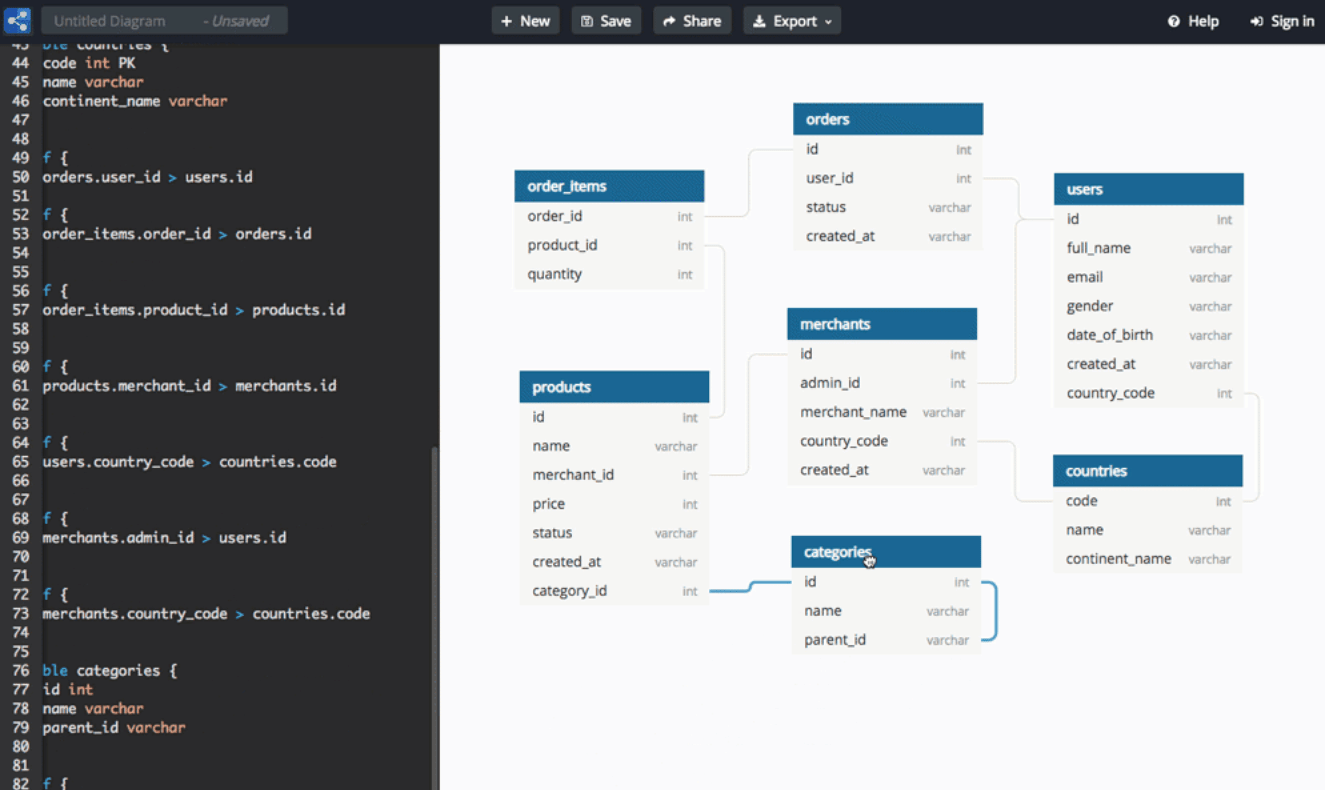
عبر مخطط DBDiagram DBDiagram هو الخيار الأفضل للمطورين والمحللين الذين يبحثون عن أداة فعالة من حيث التكلفة لمخطط علاقات الكيانات على شبكة الإنترنت. وهي تعطي الأولوية لسهولة الاستخدام، مما يسمح للمحترفين بتحويل أفكارهم إلى مخططات واضحة بأقل قدر من التعليمات البرمجية.
ولكن هنا الجزء المثير: يقطع DBDiagram شوطًا إضافيًا من خلال السماح لك بالحصول على مخططات علاقات الكيانات مباشرةً من ملفات تفريغ SQL. ويمكنه حتى إنشاء عبارات SQL لإنشاء مخطط قاعدة بيانات. تتمحور هذه الأداة حول الراحة حيث يمكنك التكامل مع أطر الويب الشائعة مثل Rails أو Django وتحميل ملفات schema.rb أو models.py في لمح البصر!
بمجرد أن تصبح مخططات ER البيانية الخاصة بك جاهزة، يمكنك تحويلها بسرعة إلى ملفات PDF ومشاركتها مع فريقك أو تعميمها داخليًا بنقرة واحدة. 🖱️
DBDiagram أفضل الميزات
- تخطيط الحد الأدنى من التعليمات البرمجية
- استيراد مخططات ER من ملفات تفريغ SQL
- تكامل إطار عمل الويب
- تمكين تحويل ملفات PDF ومشاركتها
قيود DBDiagram
- يمكن تحسين التعامل مع المفاتيح الخارجية
- تخصيصات محدودة
تسعير #### تسعير DBDiagram
- الشخصية: مجاني للأبد
- شخصية احترافية: 7.5 دولار شهريًا
- فريق: 35 دولارًا/شهرًا
\ * تشير جميع الأسعار المدرجة إلى نموذج الفوترة السنوي
تقييمات ومراجعات DBDiagram
- G2: 4.3/5 (أقل من 5 تقييمات)
- منتج هانت: 4/5 (أكثر من 30 تقييم)
6. سمارت دراو

عبر: الرسم الذكي يرقى SmartDraw إلى مستوى اسمه، حيث يقدم نهجًا خاليًا من المتاعب في تخطيط العلاقات بين الكيانات. ما يميزه هو قدرته على إنشاء ERDs تلقائيًا باستخدام قاعدة البيانات الموجودة لديك، مما يوفر مسودة أولية يمكنك تخصيصها بشكل أكبر.
تضمن مجموعته الواسعة من القوالب ذات الأشكال المستطيلة والبيضاوية والماسية المصممة خصيصًا لتخطيط ERD رحلة سلسة من الفكرة إلى الإكمال. إذا كانت القوالب لا تناسب احتياجاتك تمامًا، يمكنك اختيار الأشكال وإدخال البيانات يدويًا، مما يضمن تطابق النتائج النهائية مع رؤيتك. 👁️🗨️
أضف المخططات التي تم إنشاؤها بسهولة إلى تطبيقات Microsoft Office أو Google Workspace. يتكامل SmartDraw مع أنظمة تخزين الملفات الشائعة، مما يتيح لك تخزين المخططات دون إنشاء مجلدات وأذونات متوازية.
اطلع على أفضل بدائل SmartDraw لتوسيع نطاق البحث
SmartDraw أفضل الميزات
- قوالب مصممة مسبقًا
- إنشاء نماذج ERDs تلقائيًا من قاعدة البيانات الموجودة لديك
- عمليات تكامل مفيدة
- الدعم عبر الاتصال والدردشة والبريد الإلكتروني
قيود SmartDraw
- خيارات محدودة من الرموز
- يجد بعض المستخدمين أن حذف النص الافتراضي في القوالب يستغرق وقتاً طويلاً
تسعير #### تسعير SmartDraw
- مستخدم واحد: 9.95 دولار/شهرياً
- مستخدمون متعددون: يبدأ من 8.25 دولار شهريًا لكل مستخدم (بحد أدنى ثلاثة مستخدمين)
\ * تشير جميع الأسعار المدرجة إلى نموذج الفوترة السنوي
تقييمات ومراجعات SmartDraw
- G2: 4.6/5 (أكثر من 200 تقييم)
- Capterra: 4.1/5 (أكثر من 100 تقييم)
7. ميرو
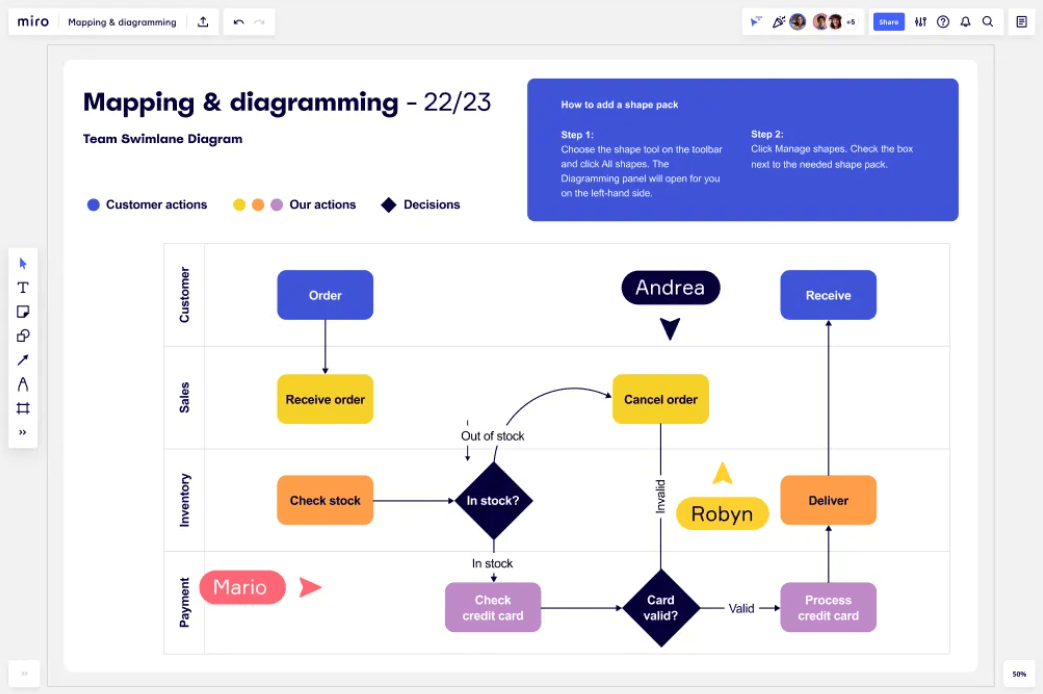
عبر ميرومثل Lucidchart و ClickUp, ميرو يدعمك بالعديد من القوالب التي تغطي كل شيء من سلاسل القيمة إلى نطاقات المشروع. يأتي قالب ERD الخاص به مع خريطة محددة مسبقًا لإنشاء نموذج البيانات الخاص بك. تتضمن الخطوات النموذجية ما يلي:
- تحديد الكيانات وتسميتها
- استخدام خطوط الاتصال (على شريط الأدوات أو باستخدام مفتاح التشغيل السريع L) لإنشاء العلاقات
- تخصيص المخطط ووضع اللمسات الأخيرة عليه
يضيف Miro لمسة سحرية مع ميزات تفاعلية متقدمة ترتقي بتجربة الرسم التخطيطي التعاوني. فكر في الأمر على أنه عصف ذهني على سبورة بيضاء حقيقية، سواء كنت في المكتب أو تعمل من المنزل. يمكن للجميع المشاركة، بفضل ميزات مثل الملاحظات الرقمية اللاصقة والرسم اليدوي. 🖍️
ميرو أفضل الميزات
- العمل الجماعي وتحرير المستندات في الوقت الفعلي
- يوفر إمكانية الوصول إلى تنسيقات ملفات متعددة
- يوفر العديد من القوالب التي تتخطى نماذج ERDs
- يتكامل مع أدوات ومنصات أخرى
قيود Miro
- قدرات محدودة غير متصلة بالإنترنت
- منحنى تعليمي حاد
تسعير ميرو
- مجاني للأبد
- مبتدئ: 8 دولارات شهريًا لكل عضو
- الشركات: 16 دولارًا/شهرًا لكل عضو
- المؤسسات: اتصل لمعرفة الأسعار
\ * تشير جميع الأسعار المدرجة إلى نموذج الفوترة السنوي
ميرو التقييمات والمراجعات
- G2: 4.8/5 (أكثر من 5000 تقييم)
- Capterra: 4.7/5 (أكثر من 3000 تقييم)
8. كانفا
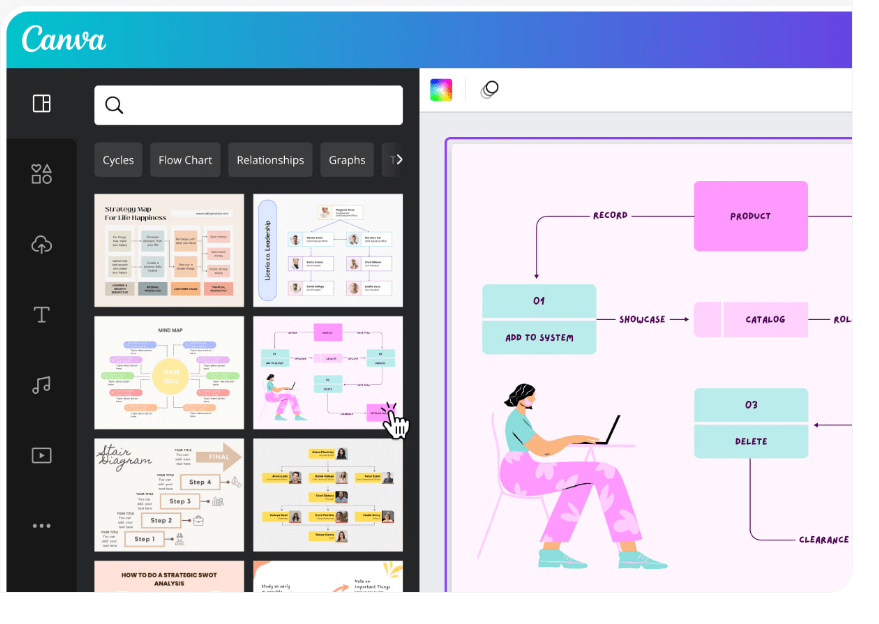
عبر: كانفا صانع مخطط ER التخطيط البياني في Canva ليس مريحًا فحسب، بل سهل الاستخدام أيضًا. فهو مبهر بميزات مرسومة بشكل جيد لعرض الروابط المعقدة داخل مجموعة البيانات الخاصة بك، مما يساعدك على اكتشاف العيوب المنطقية المحتملة أو أخطاء التصميم بشكل أسرع. 🐞
يتيح لك Canva الاختيار من بين أكثر من 20 نوعًا من أنواع الرسوم البيانية لتمثيل نماذج ER في مواقف متنوعة، مما يضمن أن تكون مخططاتك البيانية شاملة وجذابة بصريًا. كما يتيح لك أيضًا رسومًا بيانية سهلة القراءة مع نشر عالي الدقة.
ما يميز Canva هو خيارات التخصيص الغنية. يمكنك عرض الكيانات والسمات والعلاقات مع الكثير من عناصر التصميم، بما في ذلك الصور والرسومات. لمشاركة رسوماتك البيانية وتضمينها، ما عليك سوى استخدام أزرار التنزيل والتصدير المدمجة في برنامج الرسم البياني .
كانفا أفضل الميزات
- أكثر من 20 نوعًا من الرسوم البيانية
- واجهة بديهية وسهلة التنقل
- خيارات تنزيل وتصدير سهلة الاستخدام
- مجموعة واسعة من لوحات الألوان ومجموعات الخطوط
قيود كانفا
- ميزات تحرير احترافية محدودة
- قد يتأخر مع بعض عمليات التكامل
تسعير #### كانفا
- مجاني للأبد
- محترف: 14.99 دولارًا شهريًا لشخص واحد
- الفرق: 29.99 دولارًا/شهرًا لأول خمسة أشخاص
تقييمات ومراجعات كانفا
- G2: 4.7/5 (أكثر من 4,000 تقييم)
- Capterra: 4.7/5 (أكثر من 11,000 تقييم)
9. إدراو ماكس
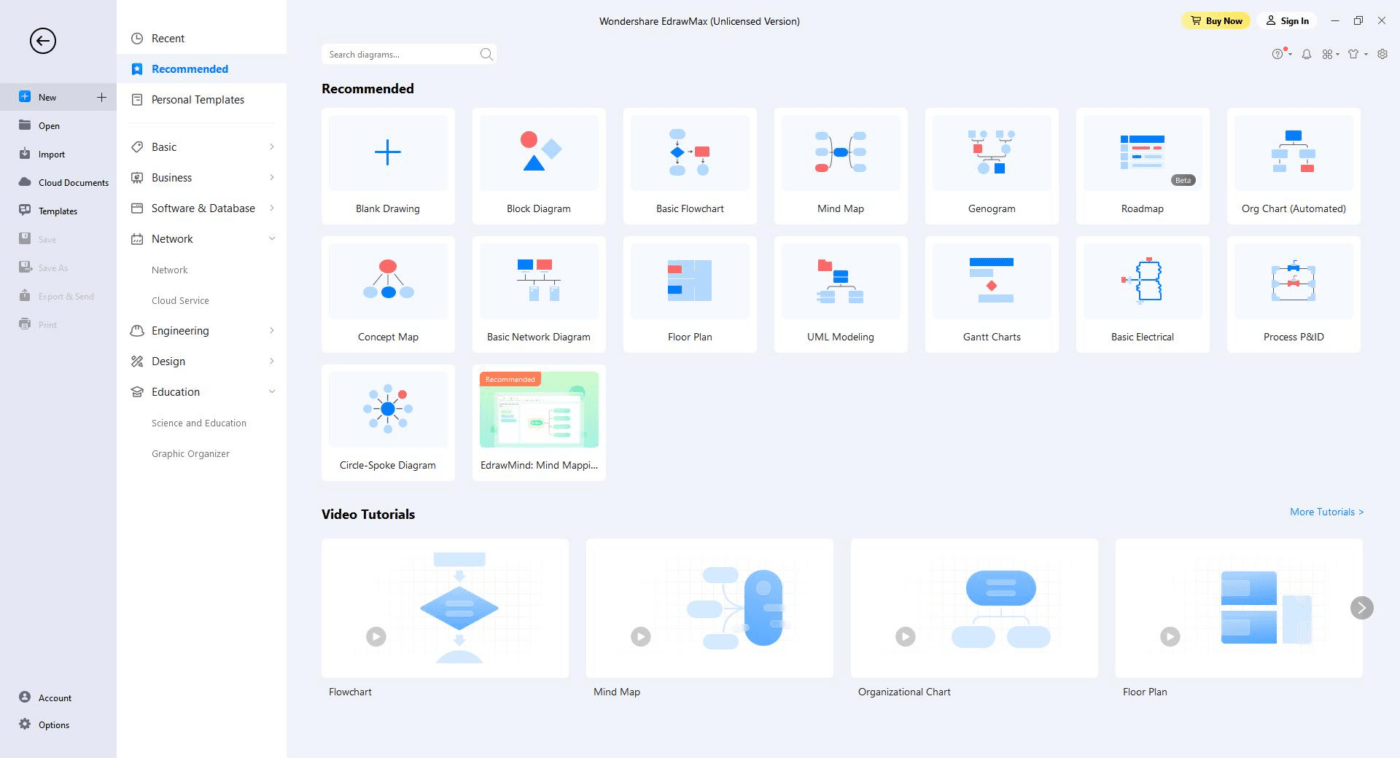
عبر: إدراو ماكس EdrawMax هو أداتك المفضلة لصياغة الرسوم البيانية والمخططات المذهلة بصريًا بسهولة. إنه مفيد لتصميم مخططات علاقات الكيانات بفضل أدوات التصميم القابلة للتخصيص والملفتة للنظر. 🌻
لإنشاء نموذج ERD جديد، افتح حساب EdrawMax الخاص بك وانتقل إلى قسم نمذجة قاعدة البيانات (على الجانب الأيسر من الشاشة). اختر من أحد القوالب للبدء، أو استخدم لوحة فارغة.
يجعل EdrawMax من السهل تحديد علاقات الكيانات المعقدة باستخدام الروابط والخطوط وتحويلها إلى مخطط علائقي. قد يساعدك المخطط الناتج على أن تصبح على دراية بالمشكلات في وقت مبكر، خاصةً إذا كنت ترغب في الحد من أخطاء النشر.
بمجرد الانتقال إلى وضع حل المشكلات، يمكنك ضبط المخطط الخاص بك عن طريق إضافة عناصر أو إزالتها. احفظ ملفاتك بأمان على السحابة أو قم بتصديرها بتنسيقات شائعة مثل PDF وVisio وHTML وSVG.
EdrawMax أفضل الميزات
- الاستخدام عبر الإنترنت وغير متصل
- ميزة الالتقاط واللصق لربط الأشكال
- تصدير الملفات بتنسيقات متعددة
- متوفر على أنظمة ويندوز وماك ولينكس
قيود EdrawMax
- يمكن أن يكون مكلفًا لبعض المستخدمين
- تحتاج ميزات تغيير الحجم والمحاذاة إلى تحسين
تسعير EdrawMax
- للأفراد
- خطة الاشتراك: 99 دولاراً في السنة
- خطة مدى الحياة: 198 دولارًا (دفعة لمرة واحدة)
- خطة باقة مدى الحياة: 245 دولارًا (دفعة لمرة واحدة)
- خطة الباقة السنوية: 126.4 دولارًا أمريكيًا في السنة
- للفرق: 505.75 دولار في السنة (لخمسة مستخدمين)
- للشركات: متاحة عند الاتصال
تقييمات ومراجعات EdrawMax
- G2: 4.3/5 (أكثر من 60 تقييم)
- Capterra: 4.6/5 (أكثر من 200 تقييم)
10. النموذج المرئي
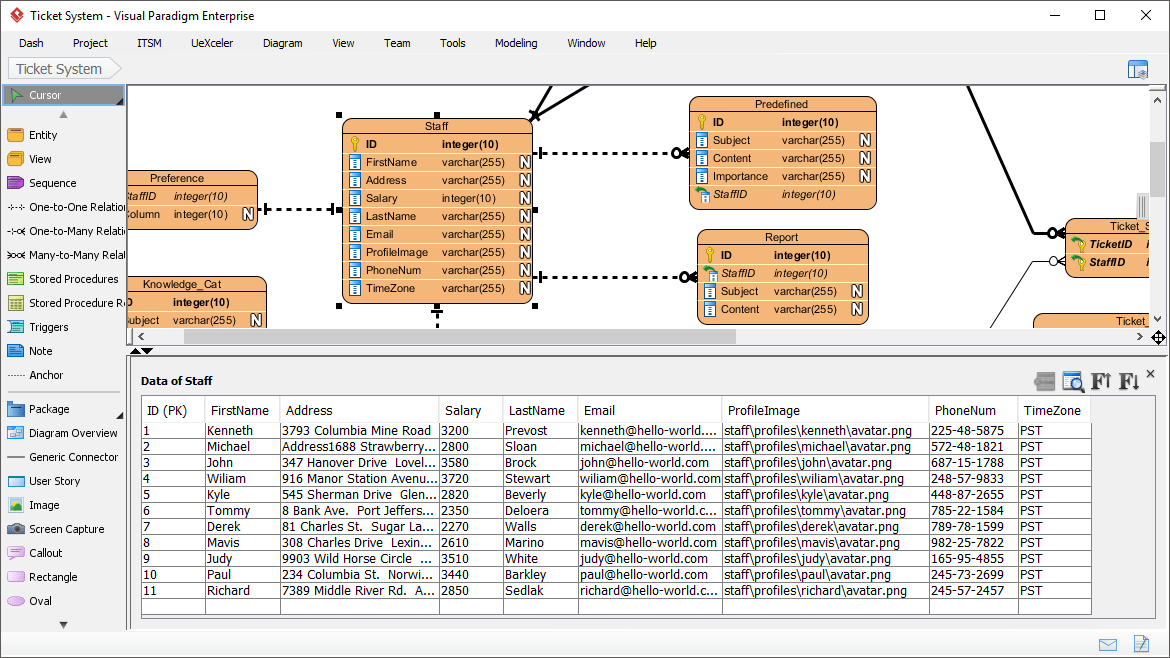
عبر: النموذج المرئي Visual Paradigm هي أداة عبر الإنترنت مع محرر سهل الاستخدام لنمذجة ERD. تضمن لك واجهته الخالية من الإعلانات أن تكون تجربتك خالية من المبيعات المشتتة للانتباه.
قم بإنشاء كيانات ERD مع مجموعات بيانات نموذجية أو استخدم نموذج Transitor لنسخ المخططات والانتقالات الموجودة. استخدم محرري سجل الجدول و عرض قاعدة البيانات لنمذجة بنية بياناتك بشكل منهجي وإضافة جداول وأعمدة وعلاقات بينية للحصول على تمثيل مرئي دقيق. يمكنك إنشاء عبارات SQL مخصصة لجداول بياناتك مباشرةً.
مع خيارات غير محدودة لإنشاء المخططات وخيارات تصدير الصور الخالية من العلامات المائية، تُعد هذه المنصة خيارًا متعدد الاستخدامات لكل من الأفراد والفرق.
Visual Paradigm أفضل الميزات
- محرر ERD بديهي
- مخططات غير محدودة للمشتركين المؤهلين
- تمكين الملاحظات والنصوص والصور
- يسمح بتكرار النماذج
قيود النموذج البصري #### قيود النموذج البصري
- تكامل دون المستوى مع الأنظمة الأخرى
- أدوات ERD غير متوفرة للمشتركين في خطط النمذجة
تسعير Visual Paradigm Paradigm
- موديلر: 6 دولارات شهرياً
- معيار: 19 دولارًا في الشهر
- احترافي: 35 دولارًا/شهريًا (نموذج فوترة ربع سنوي)
- مؤسسة: 89$/شهرياً (نموذج فوترة نصف سنوي)
تقييمات ومراجعات النموذج البصري
- G2: 4.3/5 (أكثر من 10 تقييمات)
- Capterra: 4.2/5 (أكثر من 10 مراجعات)
إتقان فن مخططات علاقات الكيانات البيانية
في سعيك للعثور على أدوات من الدرجة الأولى لصياغة مخططات علاقات الكيانات، من الذكاء دائمًا اختيار أداة تتوافق مع متطلباتك الخاصة. المنتجات التي ناقشناها اليوم يمكن الوصول إليها بشكل كبير ومتوفرة بأسعار متعددة، لذا فإن عملية اتخاذ القرار يجب أن تكون سلسة.
كخيار متميز ضع في اعتبارك ClickUp -لا يبسط الرسم التخطيطي لمديري قواعد البيانات فحسب، بل يقدم أيضًا عددًا لا يحصى من ميزات الإنتاجية الأخرى. 🤩

